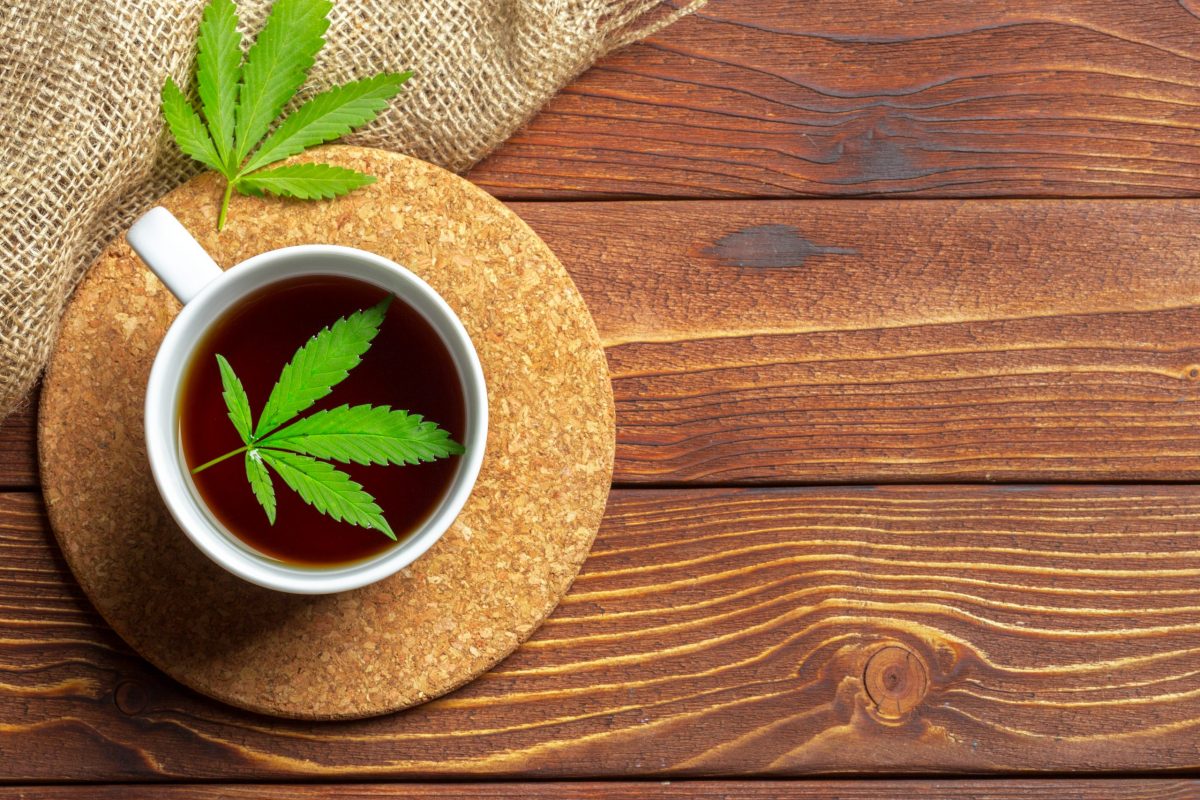
Chula Researchers Find Extensive amounts of THC in Cannabis-Flavored Drinks The Public Is Cautioned and the Government Urged to Impose Stricter Control
Research work of a biochemistry expert at Chulalongkorn University finds that over 30% of cannabis-flavored drinks randomly tested contain higher THC levels than what is permitted. The public is warned to keep their consumption to moderate levels and that children should refrain from drinking this beverage. The government should control its consumption and warn the people of the benefit and harm of cannabis.
Following the removal of cannabis and hemp from the list of controlled narcotics paving the way for their commercial and economic benefits, the market for cannabis-flavored drinks has seen a rigorous expansion. There are now such products as marijuana tea and cannabis coffee some of which may be found in vending machines making them very easily accessible to different groups of consumers.
Information from the Center for Addiction Studies’ ninth academic conference recently held in February 2022 finds that the use of cannabis in Thailand has doubled from the previous years. Research shows around 1.89 million Thais over the age of 18 or approximately 4.3% are using marijuana compared to around 1 million users in 2020.
The trend has caused some concern for medical doctors and addiction researchers who warn that impact of THC found in cannabis may affect those consuming large amounts of the substance continuously. This could affect the development of the brain while also putting them at risk for depression, psychiatric disorders, coronary vessel disorders, and testicular cancer, for example.
Chula pioneers research on ?9-THC levels in cannabis-flavored drinks
Such concerns have led Associate Professor Dr. Kuakarun Krusong of the Department of Biochemistry, Faculty of Science, Chulalongkorn University to conduct a study on ?9-THC or delta9-tetrahydrocannabinol levels in cannabis-flavored drinks to determine whether they exceed what has been determined by the Ministry of Health.
“With marijuana now being freely used as ingredients in food and beverages, this allows easy access to the general public which includes children and the youth as well. What we see in the media or advertisements usually alludes only to its benefits like recreational and medicinal use. What we might forget is that the substance can still be harmful if consumed in excess. Several doctors have warned that children refrain from consuming the substance since it can affect their physical, mental, and even emotional development,” Associate Professor Dr. Kuakarun explained how the research project with funding from the Center for Addiction Studies started.
This research project is a collaborative effort of a team of experts for example serving as the project’s advisor is Associate Professor Rasmon Kalayasiri, M.D. of the Department of Psychiatry, Faculty of Medical Science, Chulalongkorn University who is also Director of the Center for Addiction Studies, Associate Professor Dr. Sornkanok Vimolmangkang of the Department of Pharmacognosy and Pharmaceutical Botany, Faculty of Pharmaceutical Sciences whose research focus has been on marijuana and its natural substance derivatives along with Professor Dr. Orawon Chailapakul and Assistant Professor Dr. Chadin Kulsing from the Department of Chemistry, Faculty of Science both of whom lend their expertise for substance analysis to study the ?9-THC level in the samples collected from those drinks.
Results from the random tests
The research team gathered more than 30 samples from the cannabis-flavored drinks currently on sale in various outlets all over the Bangkok Metropolis which are sold as teas, coffees, and milk drinks. The technique used in the testing of ?9-THC is the GC-MS (Gas chromatography-Mass spectroscopy) which involves the separation and specification of various substances in the sampling tested as well as the HPLC (High-Performance Liquid Chromatography) that separates the mixture and provides a quantitative determination of the target substance through the use of a high-pressure pump.
“If you ask why we concentrate specifically on cannabis-flavored drinks sold in various shops, the explanation is that the readymade drinks require FDA approval with a clear label showing the contents and the amount of ?9-THC per 100 milliliters or per 1 serving size. In contrast, drinks sold in cafes are usually concocted in-house and even the same drink may have a different mixture which means the amount of ?9-THC may also be different. This is where it can become dangerous.”
According to Assoc. Prof. Dr. Kuakarun, the results of the sample testing show that “most of the drinks tested show a level of ?9-THC within the limit required by the Ministry of Health whereas around 30 % were found to contain ?9-THC at levels above what is allowed by law which is not over 0.015 milligrams per 100 milliliters. Those who happen to consume drinks with a THC level that exceeds the limit are exposing themselves to health risks, especially in the cases of those who are allergic to ?9-THC”
The research cannot, however, reveal the names of drinks or outlets and the quantities of their ?9-THC, but it is possible to include in a report to the Center for Addiction Studies, an agency that falls under the Thai Health Foundation, as a database for future policy implementation.
This year’s research (2022) is nearing its completion and Assoc. Prof. Dr. Kuakarun believes that in the future, more research samplings will take place. This might mean an expansion to other regions or the sampling of foods other than beverages.
Suggestions for safe cannabis consumption
Assoc. Prof. Dr. Kuakarun’s concern is that so far there has yet to be a recommended level of safe consumption for ?9-THC per day in Thailand. There should be, for instance, a number proportionate to 1 kilogram of a person’s weight and how many micrograms one must not exceed since it could cause side effects. The same thing could be said for foreign countries where the number is also not clear. Consumption of cannabis-flavored drinks might follow other beverages such as energy drinks with clear and familiar warnings not to exceed over 2 bottles per day.
“Even the shops or the business operators probably aren’t yet aware of the maximum level of ?9-THC per glass and even if they do there can be no real regulation since there hasn’t been any inspection taking place. Another thing is that the drinks are all made differently. It wouldn’t matter so much in the cases where the leaves are boiled and mixed into a beverage since that usually yields a rather small number of ?9-THC. If they are extracted by heat or oil there is no way to determine the level of ?9-THC per one serving.”
For this reason, Assoc. Prof. Dr. Kuakarun suggests that those who wish to experiment with cannabis or hemp-flavored drink should exercise caution and only consume moderately so as not to expose the body to high levels of ?9-THC that might cause danger since the long-term risks are not yet known.
Proposal for state regulation of places selling cannabis flavored food and drinks
Outlets for food and beverage with cannabis or hemp should have signs clearly displayed informing customers of the content of what they serve. This is to alert customers who wish to avoid those contents and parents of children who should not consume those products.
The media should publicize both the beneficial and harmful effects of marijuana
The government’s promotion of the economic benefits of cannabis and hemp has resulted in many sectors, including the media, concentrating more on their benefits while neglecting to disclose the harmful effects they could cause.
“The media now concentrates more on the benefits of marijuana as an herbal cash crop. The packaging of these products is designed to be attractive to lure customers to buy these seemingly harmless products. Even if anyone talks about the harmful side, it wouldn’t gain much traction since that is the side that doesn’t generate income and is even seen as outdated.” “But we can’t deny that there is a harmful side to this substance. There are other elements of cannabis that are harmful to one’s health but the worst is this ?9-THC we have been talking about, especially in the cases of children who might wish to try such products. I hope that the campaigns focus on both aspects. One can highlight the benefits but must not forget the potential harm they can do.” Assoc. Prof. Kuakarun reminded us with great concern.
Although cannabis and hemp have been taken off the list of narcotics, this does not mean they can be used freely. Should the level of ?9-THC exceed 0.2% of the weight the Board of Narcotics Control still considers it an addictive substance. The public should therefore be cautious when consuming food and drinks mixed with cannabis or its extraction to avoid the harmful effects it could cause in the long run.
Source: Chulalongkorn University Communication Center
